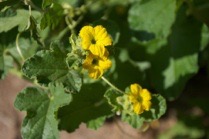
The green-colored cucumber pictured above is not ripe, when ripe it will be yellow (and bitter).
There are numerous varieties of cucumber (as you can imagine, 3,000 years of human-assisted evolution can produced a lot). There are many varietal names, some of the general types are:
- Kekiri, used almost exclusively in curries (orange in color when ripe) - found in the dry zone of Sri Lanka (the southeast);
- Dosakai, another cucumber for curries is round and yellow to orange in color - found in India;
- Apple cucumbers are mild in flavor and tend to taste sweet, they are round and yellowish in color - from New Zealand;
- Lebanese cucumbers tend to be smaller and milder in taste; and
- English varieties - the typical supermarket types found next to the iceberg lettuce.
Cucumbers are high in Vitamin C (5.5 mg per 100 grams - unpeeled) and several other nutrients/vitamins.
Along with plants like the watermelon, the indigenous peoples of North America quickly adopted the cucumber from the Spanish and added it to their core of foodstuffs. De Soto found cucumber being grown in Florida in 1539, for instance.

Another one of those wonderful gourds, Cucumis sativus, is raised around the world. Originally from India, it has been cultivated for at least 3,000 years (and may have originated about 10,000 years ago). Interestingly, only three other vegetables are known to have originated in India; eggplant, cowpeas, and Indian mustard.
Like many gourds it grows on creeping vines which crawl across the earth or climb up trellises, sunflowers, or anything else which is vertical.
The cucumber genome was sequenced in 2009.
China grows more cucumbers than any other country (about 60% of the world’s production) followed by Turkey.
Armenian Cucumber, Cucumis melo, tastes and looks like a cucumber but is really another type of gourd (a variety of muskmelon).
The Egyptian Cucumber, Cucumis chate, is reputed (Fredric Hasselquist in the 1700’s) to be the “queen of cucumbers, refreshing, sweet, solid, and wholesome”.